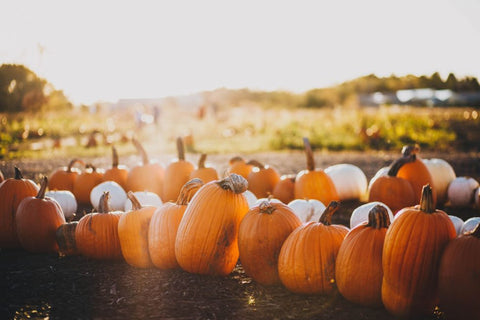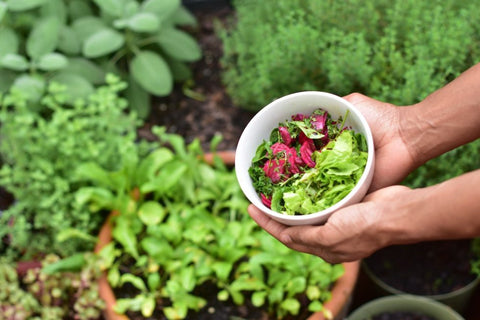Pumpkin Season is officially upon us, and you know what that means: Pumpkin Spice Lattes, pumpkin patches, pumpkin pie, carving pumpkins, canned pumpkin, pumpkin recipes, the Trader Joe’s Pumpkin specialty items, and more. If you are a gardener (or even if you’re not), pumpkin season also means harvesting your crops. If you have planted a crop of pumpkins in your garden,
you are probably eager to get to harvest. Before you begin aimlessly harvesting your pumpkins, it is important to learn how and when to harvest pumpkins off of their vines so that you can get the biggest turn around for your efforts.

When to Plant Pumpkins
If you didn’t plant any pumpkin seeds this year, but want to have a pumpkin harvest for next season, note your growing season based on your frost dates. Pumpkins do best when seeds are planted directly in the ground. You should wait until the soil is at least 70ºF before sowing seeds outdoors, with the optimum soil temperature being 95ºF. Pumpkins thrive in warmth and are sensitive to cold.
When choosing a planting site, select a spot with full sun (to light shade) and plenty of space for sprawling vines, ideally 50 to 100 square feet per hill. If space is limited, you can plant pumpkins at the edge of the garden and direct vine growth across the lawn or sidewalk. Alternatively, pumpkins can be grown in large 5 to 10-gallon buckets, or you can try miniature varieties.
How to Plant Pumpkins
Plant your seeds in small mounds to help the soil warm more quickly and speed up germination. Plant seeds 1 inch deep in the hills (4 to 5 seeds per hill) and space them 4 to 8 feet apart. The seeds should germinate in less than a week and begin to emerge within 5 to 10 days. Once the plants are 2 to 3 inches tall, thin them by snipping off unwanted plants without disturbing the roots of the remaining ones.
Remember that pumpkins need plenty of water with good drainage. They are heavy feeders, so consider treating them with manure or compost mixed with water to promote healthy growth.

When Is The Best Time to Harvest Pumpkins?
So, when should you really harvest your pumpkins? Wait until your pumpkins are fully ripe, which means they have a solid rind and a vibrant color throughout. To check for ripeness, tap on the rind—if you hear a hollow “thump” similar to a drum, your pumpkins are ready. Remember, the best time to pick pumpkins is when they are fully mature as they will store better and last longer.
Where to Buy Pumpkins Out of Season?
According to Produce Market Guide, you can buy pumpkins out of season from Ohio in December. You can also import them from other countries, such as Mexico, for the months following the typical pumpkin season.
How To Harvest Pumpkins
When you're ready to harvest, choose a dry day after the first hard frost. Cut the thick stem with strong garden shears or a sharp knife 3-4 inches from the top of the pumpkin. Carefully move the pumpkins, always carrying them from the bottom, not the stem.
How to Store Pumpkins
One of the best things about growing pumpkins is that you can store them for later use and enjoy delicious recipes throughout the next 3 months! To extend pumpkin season, cure the pumpkins for 10 days, then store them in a dry, cool environment. Place them in a single layer where the rinds do not touch each other to prevent decay.
Recommended Pumpkin Varieties
There are many pumpkin varieties, so you can mix and match to achieve your desired look, size, and taste. Here are a few varieties we love:
Pumpkin Variety We Recommend: Jack Be Little
These pumpkins cling to their vines during growth and fit in the palm of your hand at maturity. They come in white and orange and make excellent decorations.
Pumpkin Variety We Recommend: Small Sugar
Hands down the best variety for cooking pumpkin pie!
Pumpkin Variety We Recommend: Connecticut Field
This heirloom variety grows 15 to 25 pounds in size, with the classic pumpkin look.
Pumpkin Variety We Recommend: New Moon
Like a moon, this variety has bright white, smooth skin and tender flesh. It is a unique option for carving!
Pumpkin Variety We Recommend: Cinderella
Great for pumpkin pie! These are the classic bright orange, large, and round pumpkins straight from a fairytale.
If you don't have the capacity or time to grow pumpkins in your garden but still want to optimize the Fall and Winter growing seasons, check out some of our other popular blogs:
How to Grow a Garden in the Winter

There are so many gardening opportunities this season, and there's really no right or wrong way to begin. Even if you don’t grow pumpkins yourself, we hope you enjoy pumpkin season—whether that means visiting a pumpkin patch, drinking hot apple cider, or laying in the leaves. Next time you're at the store, why not pick up the ingredients for a festive Cilantro Pesto with Pumpkin Gnocchi or Roasted Pumpkin and Lentil Soup with Dill or Parsley?
Happy Harvest!









There are no comments for this article. Be the first one to leave a message!